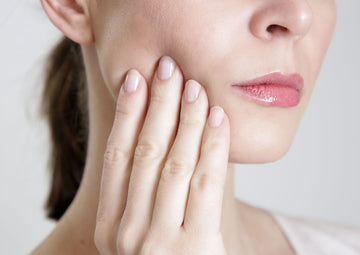

White spots are an annoying but largely cosmetic issue that can crop up on the surface of teeth. If you’re unhappy with the look of white spots on your teeth, the good news is that there are several ways to fix and prevent them from happening in the future, including teeth whitening and making healthy adjustments to your diet.
What Causes White Spots on Teeth?
Getting your teeth to that perfect shade of white requires a mix of practicing healthy dental hygiene habits, watching what you eat and drink, and finding the perfect teeth whitening product. And while white teeth are often the goal, sometimes unwanted white spots appear on your pearly whites.
Most of the time they’re harmless, though undesirable, blemishes on our teeth. But in some cases, they can indicate tooth decay happening beneath the surface of the tooth.

To help you determine what may be causing the white spots on your teeth, here are a few of the most common reasons:
Demineralization
When plaque is able to build up on the enamel of your teeth, demineralization can happen. This causes decalcification — or white spots — on the teeth. Demineralization is often caused by poor oral hygiene or in people who have braces. These white spots are early cavities that can be reversed if treated quickly.
Diet
Consuming acidic food and drink takes a toll on our teeth and can cause white spots to appear. This is because highly acidic foods and beverages such as citrus juices, fish and seafood, and red wine eat away at the tooth’s enamel, which is the outermost layer serving as a protective barrier to the sensitive nerve endings below.
Diets lacking calcium can also result in white spots on the teeth because the enamel itself is weak. To avoid this, eat a high-calcium diet by adding in dairy, nuts, and lots of leafy greens.
Bacterial Overgrowth
Another common cause of white spots on teeth is too much bacteria in the mouth. Our mouths provide a perfect environment for bacteria to thrive in because it’s a highly acidic environment. To avoid bacterial overgrowth, brush your teeth twice a day every day and incorporate flossing into your dental hygiene routine.
Fluorosis
Fluoride can act as protective armor against tooth decay, but too much of it can have a negative effect on your teeth. Too much fluoride can cause decay and discoloration in your teeth, leading to those pesky white spots. This often happens when children drink too many beverages with fluoride or when they swallow toothpaste.
You can help your child learn proper brushing habits by following the American Dental Association’s guidelines for brushing. For example, you can brush alongside your child to ensure they’re brushing for the proper length of time and spitting out excess toothpaste.
Enamel Hypoplasia
Enamel hypoplasia happens when you have less enamel on your teeth than normal. This can be caused by nutrient deficiencies leading to mineral loss in the tooth and white or brown spots appearing on the tooth’s surface.
This occurs most often in children. If you have enamel hypoplasia, your dentist will be closely monitoring the white spots, as your teeth may be more prone to tooth decay in those areas.
Sleeping With an Open Mouth
Another common cause of white spots on teeth is sleeping with an open mouth. When you leave your mouth open as you sleep, white spots can develop due to dehydration of the enamel. However, these typically fade away during the day once your mouth is closed and your teeth are once again coated with saliva.

How to Get Rid of White Spots on Your Teeth
If you’re wondering whether white spots can go away, the short answer is yes in most cases. We’ve covered a number of issues that cause white spots on your teeth, and for many of them, there are easy fixes.
Enamel Microabrasion
This is a procedure done by your dentist that removes a small amount of the enamel from the surface of your tooth to reduce the appearance of white spots. Enamel microabrasion is typically paired with teeth bleaching to make your teeth appear to be the same color across the entire surface.
Teeth Whitening or Bleaching
Bleaching is a teeth whitening procedure that’s performed by a dentist. This process lightens the entire tooth so that it matches the color of the white spots. Teeth whitening products can also attain this result as they whiten the entire tooth.
Be careful to ensure that the cause of your white spots is not fluorosis before bleaching your teeth, as bleaching white spots caused by excessive fluoride can actually make the white spots worse.

Dental Veneers or Bonding with Dental Composite
Another avenue is to consider dental veneers. You can hide your white spots under a layer of porcelain veneer that’s custom-fabricated to fit the surface of your teeth. These veneers can be color-matched to seamlessly blend with the rest of your teeth.
If you only have one or two white spots, bonding with dental composite is another option. It’s possible that your dentist may be able to cover just the spots with the dental composite rather than covering the entire front of the tooth with a veneer.
Topical Fluoride
A solution for those with enamel hypoplasia, topical fluoride can be administered by a dentist to encourage the enamel to strengthen and help prevent tooth decay.
How to Prevent White Spots on Your Teeth
A proper dental hygiene routine of twice-daily brushing for two minutes each time and regular flossing can make a world of difference in preventing white spots on your teeth. While there are many methods for treating white spots on your teeth, there are a few other steps you can take today to prevent white spots from ever appearing on your teeth.
Reduce Sugary and Acidic Food and Drink
Sugar and acidic foods create an ideal environment for bacteria to grow, which can lead to weakened enamel and white spots on teeth. Try to limit your intake of sugary and acidic food and drink to keep your teeth healthy.
Make Regular Trips to the Dentist
One of the best things you can do to prevent white spots on your teeth is to make regular visits to your dentist. He or she can pinpoint the cause of white spots and help you create a plan to treat and prevent white spots.
Bottom Line: White Spots on Teeth Can Be Fixed
Once you determine what’s causing the white spots on your teeth, you can choose the best plan for treating and removing those pesky spots from the surface of your teeth. And because the goal is to have your entire tooth white (not just spots!), teeth whitening products offer an easy way to do this at home on your own schedule.



